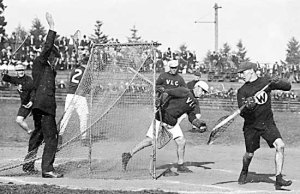
1909–1915 …The National Game reigns over the West Coast
The infamous gunshot incident of 1908, still talked about amongst fans as late as the 1950s, slipped off the attention of league executives by the start of the following season, buried under the growing contentious debate regarding professionalism in the sport.
During the 1908 season, New Westminster Salmonbellies, an amateur team, challenged and defeated the Montréal Shamrocks and Ottawa Capitals, both professional teams, for the Minto Cup – which was awarded to the professional champion of Canada. Now tainted for playing against professionals, New Westminster’s players had their amateur status revoked. As a result, in 1909 the British Columbia Amateur Lacrosse Association went professional and the organisation became a league known as the British Columbia Lacrosse Association – although some amateur players were allowed and did compete alongside the professional players that season.
The bulk of the senior amateurs then formed a new organisation called the Pacific Coast Amateur Lacrosse Association. Around the same time, the British Columbia Coast Lacrosse Association formed on May 9, 1909 to replace the former BCALA as the provincial governing body for amateur players.
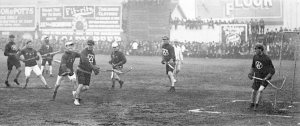
The professional BCLA consisted of New Westminster Salmonbellies and the Vancouver Lacrosse Club and would stay at two member teams throughout its entire tenure – although as we shall see, many a season would be abandoned due to squabbling between clubs and owners. On July 24, 1909, the Vancouver Lacrosse Club won their first away game in four years, drubbing the Royal City squad 6-1 in front of the largest crowd out so far that season.
On February 23, 1911, the Mount Pleasant Maple Leafs senior team decided to apply for membership in the professional league representing as the North Vancouver Lacrosse Club. While the prospective third team began the process to get itself organised, infighting within the former club soon broke out – to the point that both the Maple Leafs and North Vancouver submitted separate applications during the following month, bogged down by bureaucratic, political details and threats of court injunctions. While both the New Westminster Salmonbellies and the Vancouver Lacrosse Club seemed agreeable to a second Vancouver-based team (North Vancouver would play its matches in Vancouver, and not on the North Shore), it was obvious that a four-team pro league was not feasible due to limited money and talent to go around for everyone. Ultimately the issue was resolved when two test matches were arranged in the pre-season pitting the North Vancouver squad against the two pro clubs. After being soundly defeated by results of 12-3 and 13-3, their application was quickly rejected – and further talk of expanding the league was quickly silenced.
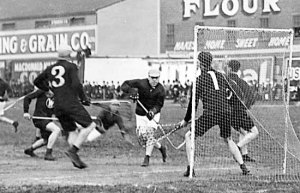
The 1911 campaign probably stands, even to this day, as the high-water mark of British Columbian lacrosse in terms of both quality on the field and popularity in the stands. Édouard ‘Newsy’ Lalonde, regarded as the greatest lacrosse player of the first half of the 20th century, was signed on for $3,500 ($72,000 in modern currency) – an incredible sum of cash in those days for a professional athlete. The series between the two local rivals was very close and intense; the regular season resulting in a draw in the standings and a two-game, total-goals playoff was required to determine that year’s Minto cupholders. Vancouver secured their first ever shutout against the hated Salmonbellies during the second of a pair of exhibition matches held in honour of the royal coronation. Crowds were huge, the 12,045 that weathered out a drizzled Dominion Day afternoon at Recreation Park was believed to have been a record breaker. Crowds in the range of 8,000 – in excess of the record numbers just ten years prior – were considered the norm of the day and the attendance record would be surpassed again when the Toronto Tecumsehs unsuccessfully challenged the Vancouver Lacrosse Club for the Minto Cup in October.
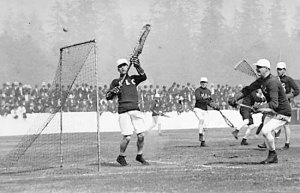
After three seasons of unprecedented popularity, the BCLA season collapsed seven games into the 1913 campaign. The Salmonbellies again had issues with the Vancouver club and had refused to start their Dominion Day match, walking off the field in protest. After almost two weeks with no agreement in the dispute, Con Jones pulled the plug on his Vancouver Lacrosse Club team and withdrew from the league on July 17, 1913 – refunding $5,000 in ticket revenue to disappointed fans as the sport now skidded into the doldrums.
With Vancouver club president Con Jones, the famous local sports promoter and owner of a chain of tobacconist’s shops, now calling it quits and out of the picture, popular interest in the game began to wane. More than any other individual, Jones was responsible for the promotion and growth of enthusiastic public support of lacrosse in the heady days of the early 1910s with his vast sums of money thrown around for signing players. His ‘retirement’ now coincided with the gradual departure of lacrosse from the sporting public’s hearts and minds.
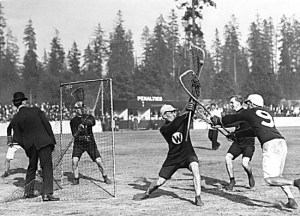
After a successful PCALA season, the Vancouver Athletic Club fielded a professional team in 1914 and replaced the departed Vancouver Lacrosse Club in the BCLA. However, they too failed to make it to the end of the season as the club disbanded on July 8, 1914 – which sadly saw the end of one of the more promising pro seasons on the pitch to have come along in a few years.
For an all-too-brief moment in time, a pro league called the Western Lacrosse Association was formed in 1915 as a replacement for the (temporarily folded) BCLA with teams in Vancouver and Victoria. After the initial announcement of this newly formed league, no further reference was ever made to it again. New Westminster soon returned to the pro fold along with Vancouver – and, so too did Con Jones. Victoria was then quietly dropped and as far as anyone was concerned, the BCLA was back in business as per usual.
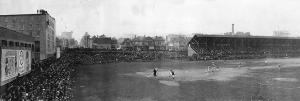
The British Columbia Amateur Lacrosse Association was formed in May 1915, six years after the demise of the previous BCALA incarnation as yet another provincial lacrosse body. There were now a whole host of provincial bodies abound: the BCALA, the PCALA, and the BCCLA organisations in the amateur ranks and the BCLA for the professional players.
Con Jones himself would soon fall into financial difficulties. With the Vancouver club mired in debt to the amount of $2,300 just two months into the 1915 season, Jones showed his accounting books to the Vancouver players and stated he would not be paying them for the rest of the season. The three Easterners that he had imported in for the season packed up and left for home the following week.
1916–1917 …Patriotic Lacrosse during the Great War
Organised Lacrosse fell by the wayside in 1916 and suspended operations for the remainder of the First World War as the war effort took centre-stage attention. When club officials in New Westminster refused to field a team in 1916 and for the rest of the duration of the war, Con Jones continued to plan and recruit players in early April 1916 for a potential pro campaign involving two Vancouver clubs. However, a BCLA league meeting held on the evening of April 18, 1916 stopped those plans dead in their tracks when it was decided that “in the interest of the Empire’s fight, it would be better if professional lacrosse were suspended on the Pacific Coast until after the end of the war”.
In the absence of the pro and amateur leagues, 1916 would see a couple exhibition games arranged by old-timer teams for patriotic fund raising while 1917 would feature a five-game ‘patriotic lacrosse series’ between two squads called the Vancouver Patriotic Club and the Maple Leafs – featuring an unprecedented mix of professional and amateur players from Vancouver and New Westminster, with all profits going to charities associated with the war effort.
The initial old-timers’ match, played at Brockton Point on Dominion Day of 1916, was attended by 2,500 to 3,000 fans and raised $1700 for the Returned Soldiers Fund. In the following year, work was begun starting in January and through into the spring months to revive lacrosse.
At a formal meeting held on April 18, 1917, twenty-seven players from Vancouver and New Westminster decided to organise a patriotic lacrosse series with the entire profits to be contributed to patriotic charities. Many of the players who were married or otherwise unable to go overseas, nevertheless wanted to do their part in assisting in the war effort. Finances were handled by the British Columbia Amateur Athletic Union (BCAAU) due to one of the stipulations required to preserve the amateur status of the amateur players who would be playing alongside their professional brethren. Players were paid by means of a co-operative system with a portion of the gate receipts going to the Canadian Patriotic Fund.
In addition to the patriotism aspect, the series was used to keep public interest in the game with the post-war years in mind. Boys under the age of fourteen were admitted for free, in the hopes it would encourage future interest and participation in the sport. The rosters were somewhat fluid as players came and went. For the first three games, the teams were the Vancouver Patriotic Club and the Maple Leafs. In the fourth match, New Westminster featured in a combined Maple Leafs squad versus Vancouver.
(PHOTOS CVA 371-578; CVA 371-596; CVA 371-583; CVA 371-578; Sp P71; PAN P87)